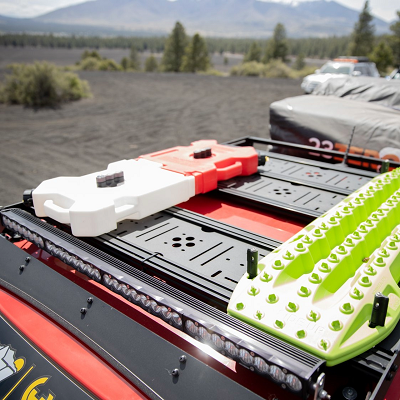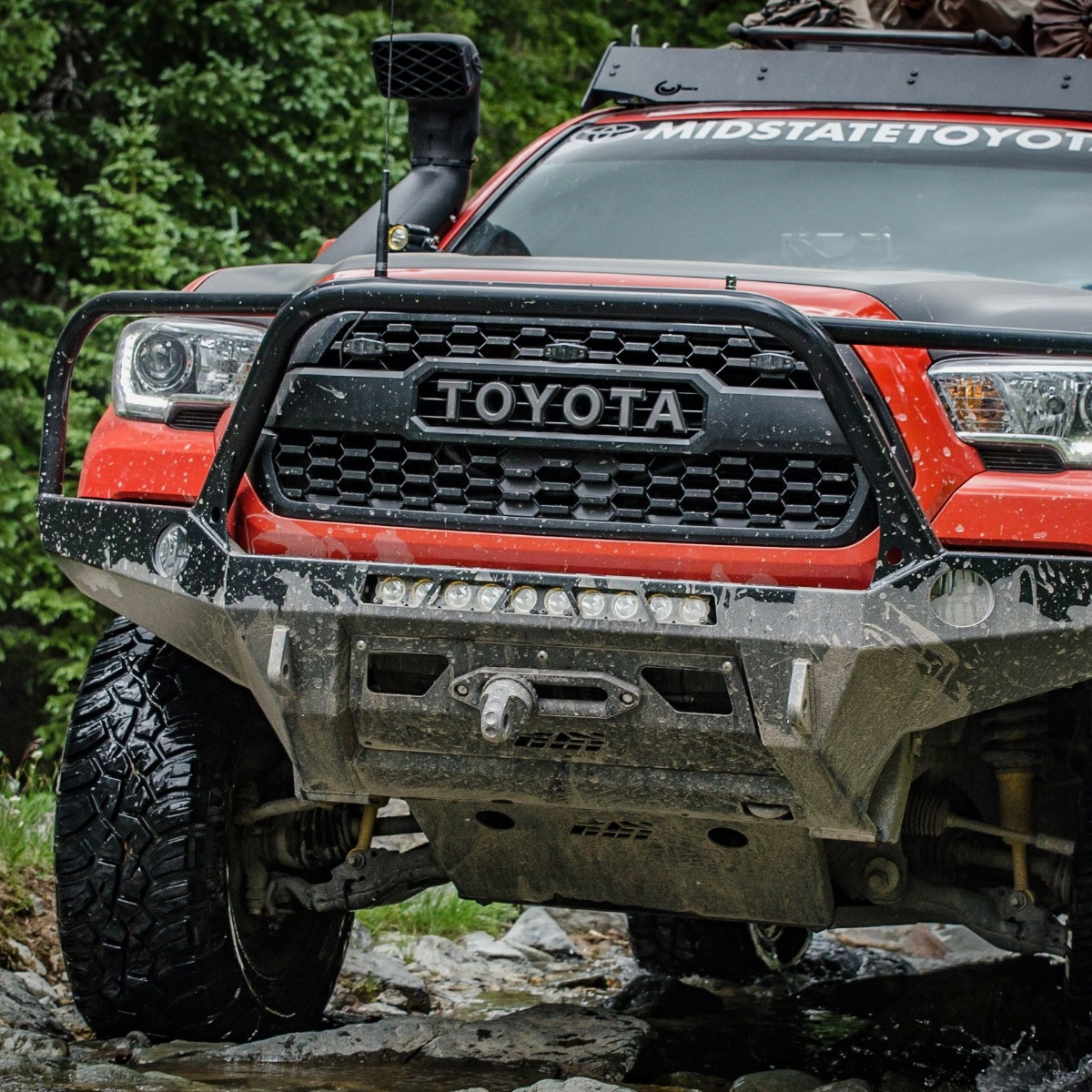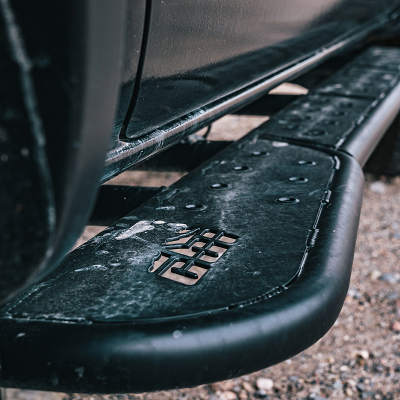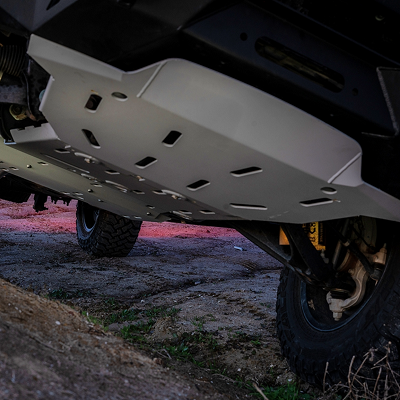Your Cart is Empty

Shop By Vehicle:

Roof Racks
Bed Racks

Front Bumpers

Rear Bumpers

Rock Sliders

Skid Plates
March 14, 2024 6 min read
Considering a Tacoma exhaust reroute for better off-road capabilities? This guide explains the advantages, such as improved ground clearance, and walks you through the modification process. Learn why rerouting your Tacoma's exhaust could be the upgrade you need to tackle tough trails with more confidence and less risk to your vehicle's underbelly.
The Toyota Tacoma is renowned for its capability and reliability. However, its exhaust system, which hangs down 1-2 inches below the frame rail in the center of the truck, can be a vulnerability and wreck your day on the trails. Rocks, ruts, and other trail obstacles can easily come into contact with the exhaust pipe, posing a risk of damage.
An exhaust reroute is a modification that helps mitigate this risk. By rerouting the exhaust pipe, the exhaust system is less likely to come into contact with trail obstacles, enhancing the vehicle's off-road capability. While an exhaust reroute can also boost airflow, this is not the primary reason for the modification. In some cases, a reroute of the exhaust system may be necessary to ensure optimal performance and protection.

The rerouting process involves cutting out a portion of your stock exhaust right behind the transfer case, bending a new exhaust tube in two spots, and ultimately attaching the newly bent tube to the existing exhaust. It's a task best left to professionals at an exhaust shop, particularly those experienced with Tacoma exhaust systems.

Tacoma Exhaust with Reroute
The beauty of an exhaust reroute is that it doesn't necessarily limit your customization options. Aftermarket skid plates from CBI Offroad, RCI Offroad, and more, are available to accommodate exhaust reroutes. These skid plates can provide additional protection for your Tacoma's undercarriage during off-road adventures.
An exhaust reroute offers several benefits. One of the most significant benefits is enhanced ground clearance. This improvement can minimize the risk of undercarriage damage when driving off the beaten path.
Additionally, rerouting the exhaust can potentially lead to smoother exhaust flow. While this is not the primary reason for an exhaust reroute, it's worth noting that better exhaust flow can contribute to improved gas mileage and increased engine power.
Rerouting the 3rd gen Tacoma's exhaust adds a couple of inches of ground clearance, enhancing the vehicle's ability to traverse difficult terrain. Just a couple of inches can make a big difference. This extra clearance ensures the exhaust system is not the lowest point under the vehicle, which complements other off-road enhancements such as full skid packages or the use of oversized tires.
The additional clearance not only protects the exhaust system but also allows for the installation of flat skid plates. These skid plates provide a smoother undercarriage surface, reducing the chances of getting hung up on an obstacle.
In contrast, the stock Tacoma routing would require skid plates with a notch to accommodate the exhaust pipe. Such notches can potentially become snag points on the trail, hindering your ability to get over certain obstacles.
Therefore, an exhaust reroute is a worthwhile modification for Tacoma owners planning to venture off the beaten path regularly. It's an effective way to maximize your vehicle's off-road potential while reducing the risk of costly damage.
Another potential benefit of an exhaust reroute is improved engine performance. Some argue that rerouting the exhaust results in a smoother flow that reduces back pressure, which could lead to increased torque and horsepower. These improvements could enhance your Tacoma's overall performance, particularly during demanding off-road conditions.
However, it's worth noting that this potential benefit is a subject of debate among Tacoma owners and enthusiasts. While some attest to noticeable performance gains after an exhaust reroute, others report no significant changes.
Regardless of the debate, an exhaust reroute's primary benefit remains the enhanced ground clearance and the associated off-road advantages. Any potential performance gains should be considered a bonus rather than the primary reason for undertaking this modification.
In the end, the decision to reroute your Tacoma's exhaust should be based on your individual needs, preferences, and driving habits. If you frequently find yourself on challenging terrains and seek to maximize ground clearance, an exhaust reroute could be a beneficial addition to your vehicle.
When planning an exhaust reroute for your Tacoma, it's crucial to consider who will complete the work. This task requires bending new exhaust tubing and welding it to the existing exhaust, which often requires professional skills and equipment.
We recommend contacting a muffler shop with experience in Tacoma exhaust reroutes. While most muffler shops should be able to handle the task, those with specific experience with Tacomas can often provide better results and avoid potential pitfalls.
Before choosing a shop, it's a good idea to seek recommendations from other Tacoma owners. You can also call potential shops to inquire about their experience with Tacoma exhaust reroutes. By taking the time to research and select the right shop, you can ensure a successful and beneficial reroute.
Even if you're relying on an exhaust shop for the installation, you need to keep some things in mind to ensure a successful exhaust reroute. One important factor is the material used for the new exhaust tubing. It should be of high quality to withstand the rigors of off-roading and resist corrosion over time. Stainless steel is a great option that will not corrode over time.
Another crucial aspect is the distance of the rerouted exhaust from other critical parts of your Tacoma, such as the transfer case and drive shaft u-joint. Proper placement can prevent potential heat-related issues and ensure the longevity of these components. If you are concerned with heat adding a heat shield between the new exhaust pipe and the transfer case could help protect components.
Lastly, consider the route of the new exhaust. It should be planned carefully to maximize ground clearance without compromising vehicle performance or safety. A well-executed exhaust reroute can enhance your Tacoma's off-road capability while offering potential performance improvements.
The Toyota Tacoma is an excellent vehicle out of the box. However, an exhaust reroute can further enhance its capabilities by increasing ground clearance and potentially improving engine performance. While the reroute process requires professional expertise and careful planning, the end result can be a more robust and capable off-road machine.
Whether you're an avid off-roader or simply seeking to maximize your Tacoma's potential, an exhaust reroute is a modification worth considering that will not break the bank. Not only can it enhance your vehicle's ability to tackle challenging terrains, but it can also offer peace of mind knowing your exhaust system is protected from potential trail damage.
A Tacoma exhaust reroute involves rerouting the exhaust and eliminating the pipe that hangs down below the frame rails behind the transfer case. This usually results in 1-2 inches of added ground clearance and tucks the exhaust between the frames and reduces its exposure.
Rerouting the exhaust may potentially lead to increased torque and horsepower due to improved exhaust flow, but this is a topic of debate among experts.
You should have a muffler shop with experience in Tacoma exhaust reroutes complete the work as it requires specialized skills like bending new exhaust tubing and welding.
Yes, you can install aftermarket skid plates to accommodate exhaust reroutes and provide added protection for your vehicle's undercarriage. Ensure that the skid plates you are adding can complement the exhaust reroute. Skid plates for Tacomas with a stock exhaust are built differently than those with an exhaust reroute.
Comments will be approved before showing up.
Sign up to get the latest on sales, new releases and more …